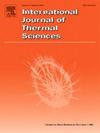Experimental study on supercritical carbon dioxide convective heat transfer in fractured rocks
IF 4.9
2区 工程技术
Q1 ENGINEERING, MECHANICAL
International Journal of Thermal Sciences
Pub Date : 2025-03-31
DOI:10.1016/j.ijthermalsci.2025.109874
引用次数: 0
Abstract
This study developed an innovative flow-heat transfer experimental system that can cover the operating range of subcritical to supercritical pressures (up to 60 MPa) and accurately simulate real geological conditions. Utilizing supercritical CO2's superior thermophysical properties, we conducted a series of well - designed convective heat transfer experiments within a smooth/artificial fracture of Sichuan outcrop rocks. The key parameters influencing the heat transfer, such as rock properties, morphology of fracture, injection flow, and the initial temperature of rock sample, were measured and analyzed. A new correlation formula was developed, showing a 25 % deviation from classical models but achieving a 4.37 % mean absolute error against experimental data. Test results show that the high temperature heat energy of nearly 60–70 °C can be recovered from the sandstone reservoir, which is higher 10 °C than that of the carbonate rock. The initial temperature of the sample directly affects the fluid physical property, and lead to change of heat transfer performance and production. Under the same initial temperature, the higher flow rate, the faster the production temperature drops. Due to the neglect of thermodynamic expansion effect in traditional fluid mechanics analysis, the influence of thermodynamic expansion on flow acceleration is deduced from the measurement of experimental temperature and pressure gradient, and a modified continuous equation including acceleration term is proposed to describe the flow process more accurately. It provides theoretical basis and technical support for optimizing geothermal energy storage system, and helps to improve energy utilization efficiency and reduce carbon emissions.
裂隙岩体超临界二氧化碳对流换热实验研究
本研究开发了一种创新的流动换热实验系统,可以覆盖亚临界到超临界压力(高达60 MPa)的工作范围,并能准确模拟真实的地质条件。利用超临界CO2优越的热物性,在四川露头岩石光滑/人工裂缝内进行了一系列精心设计的对流换热实验。对岩石性质、裂隙形态、注入流量、岩样初始温度等影响传热的关键参数进行了测量和分析。建立了一个新的相关公式,与经典模型有25%的偏差,但与实验数据的平均绝对误差为4.37%。试验结果表明,砂岩储层可回收近60 ~ 70℃的高温热能,比碳酸盐岩储层高10℃。样品的初始温度直接影响流体的物理性质,并导致传热性能和产量的变化。在初始温度相同的情况下,流量越大,生产温度下降越快。针对传统流体力学分析忽略热力学膨胀效应的问题,从实验温度和压力梯度的测量出发,推导了热力学膨胀对流动加速度的影响,并提出了包含加速度项的修正连续方程,以更准确地描述流动过程。为优化地热能储存系统提供理论依据和技术支持,有助于提高能源利用效率,减少碳排放。
本文章由计算机程序翻译,如有差异,请以英文原文为准。
求助全文
约1分钟内获得全文
求助全文
来源期刊

International Journal of Thermal Sciences
工程技术-工程:机械
CiteScore
8.10
自引率
11.10%
发文量
531
审稿时长
55 days
期刊介绍:
The International Journal of Thermal Sciences is a journal devoted to the publication of fundamental studies on the physics of transfer processes in general, with an emphasis on thermal aspects and also applied research on various processes, energy systems and the environment. Articles are published in English and French, and are subject to peer review.
The fundamental subjects considered within the scope of the journal are:
* Heat and relevant mass transfer at all scales (nano, micro and macro) and in all types of material (heterogeneous, composites, biological,...) and fluid flow
* Forced, natural or mixed convection in reactive or non-reactive media
* Single or multi–phase fluid flow with or without phase change
* Near–and far–field radiative heat transfer
* Combined modes of heat transfer in complex systems (for example, plasmas, biological, geological,...)
* Multiscale modelling
The applied research topics include:
* Heat exchangers, heat pipes, cooling processes
* Transport phenomena taking place in industrial processes (chemical, food and agricultural, metallurgical, space and aeronautical, automobile industries)
* Nano–and micro–technology for energy, space, biosystems and devices
* Heat transport analysis in advanced systems
* Impact of energy–related processes on environment, and emerging energy systems
The study of thermophysical properties of materials and fluids, thermal measurement techniques, inverse methods, and the developments of experimental methods are within the scope of the International Journal of Thermal Sciences which also covers the modelling, and numerical methods applied to thermal transfer.
 求助内容:
求助内容: 应助结果提醒方式:
应助结果提醒方式:


